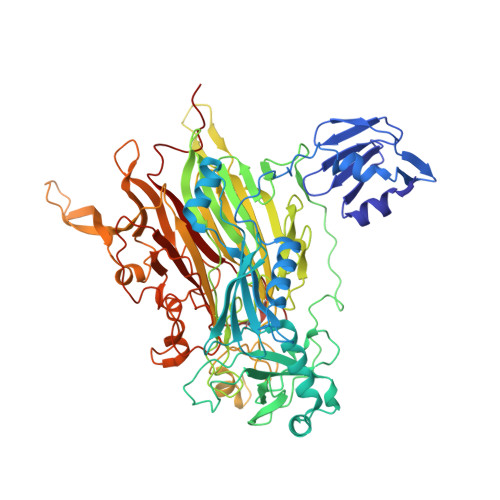Exploring the Roles of the Metal Ions in Escherichia Coli Copper Amine Oxidase.
Smith, M.A., Pirrat, P., Pearson, A.R., Kurtis, C.R., Gaule, T.G., Knowles, P.F., Phillips, S.E., McPherson, M.J.(2010) Biochemistry 49: 1268
- PubMed: 20052994
- DOI: https://doi.org/10.1021/bi901738k
- Primary Citation of Related Structures:
2WO0, 2WOF, 2WOH - PubMed Abstract:
To investigate the role of the active site copper in Escherichia coli copper amine oxidase (ECAO), we initiated a metal-substitution study. Copper reconstitution of ECAO (Cu-ECAO) restored only approximately 12% wild-type activity as measured by k(cat(amine)). Treatment with EDTA, to remove exogenous divalent metals, increased Cu-ECAO activity but reduced the activity of wild-type ECAO. Subsequent addition of calcium restored wild-type ECAO and further enhanced Cu-ECAO activities. Cobalt-reconstituted ECAO (Co-ECAO) showed lower but significant activity. These initial results are consistent with a direct electron transfer from TPQ to oxygen stabilized by the metal. If a Cu(I)-TPQ semiquinone mechanism operates, then an alternative outer-sphere electron transfer must also exist to account for the catalytic activity of Co-ECAO. The positive effect of calcium on ECAO activity led us to investigate the peripheral calcium binding sites of ECAO. Crystallographic analysis of wild-type ECAO structures, determined in the presence and absence of EDTA, confirmed that calcium is the normal ligand of these peripheral sites. The more solvent exposed calcium can be easily displaced by mono- and divalent cations with no effect on activity, whereas removal of the more buried calcium ion with EDTA resulted in a 60-90% reduction in ECAO activity and the presence of a lag phase, which could be overcome under oxygen saturation or by reoccupying the buried site with various divalent cations. Our studies indicate that binding of metal ions in the peripheral sites, while not essential, is important for maximal enzymatic activity in the mature enzyme.
- Astbury Centre for Structural Molecular Biology and Institute of Molecular and Cellular Biology, Faculty of Biological Sciences, University of Leeds, Leeds LS2 9JT, UK.
Organizational Affiliation:




















